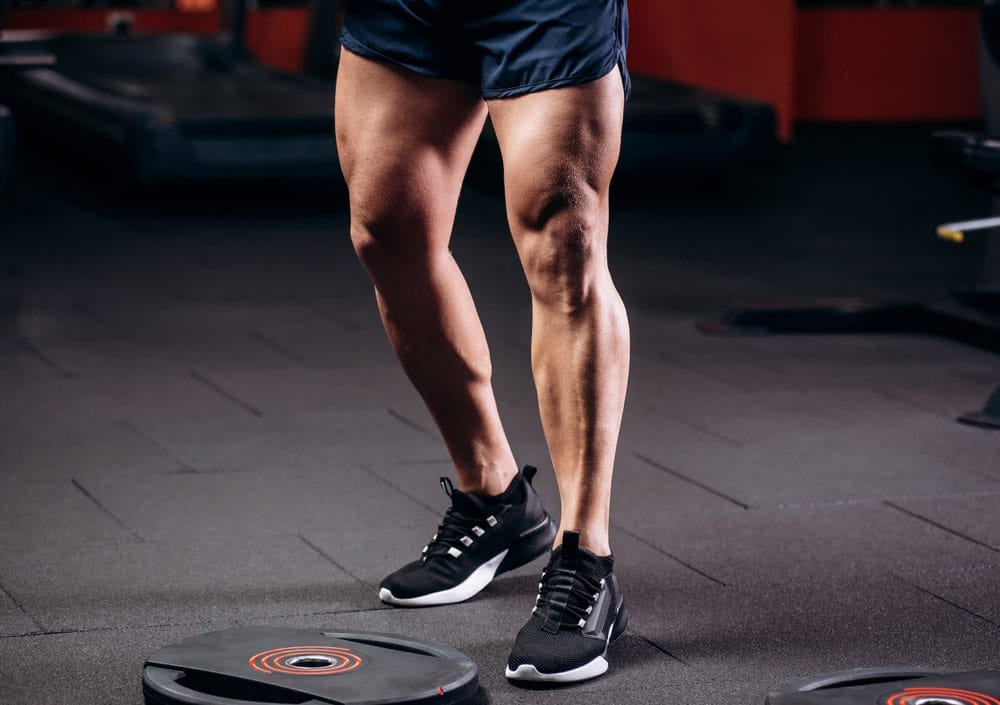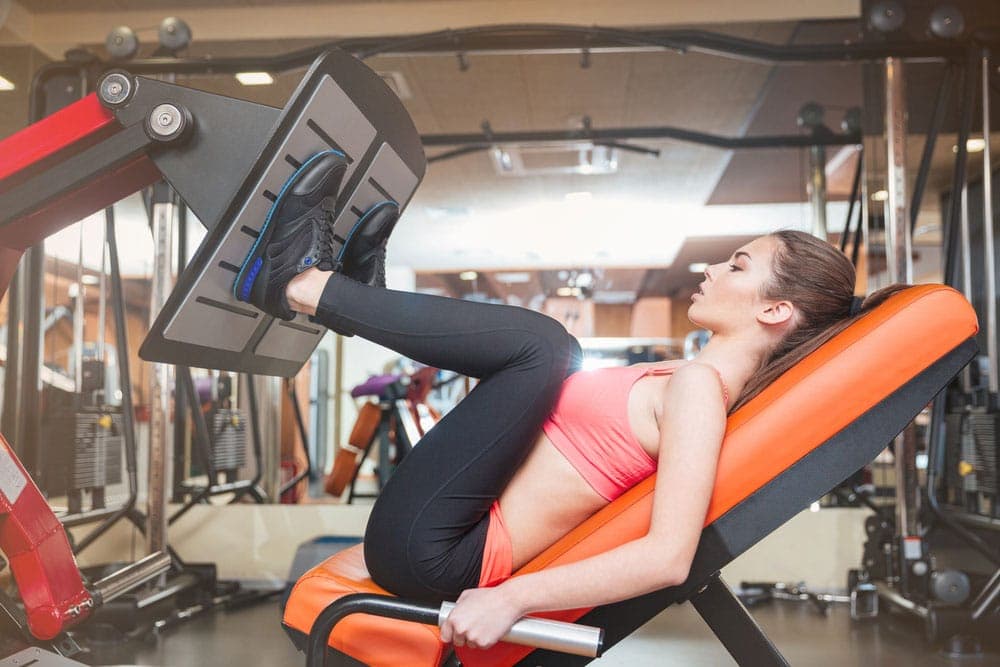Leg Press Starting Weight: Should You Go Heavy on Leg Press?
This guide will help you work effectively toward increasing your leg press and understanding strength standards.
They say go big or go home, but is this true when it comes to your leg press?
The best leg press starting weight to use may be more than you think and maybe more than you ever thought you were capable of!
If you want to understand what your baseline weight should be for a leg press, continue reading to get the lowdown on the best leg press starting weights for men and women of various sizes.
Leg Press Machine— Muscles Worked

The leg press targets four primary areas of the legs:
Quadriceps
The quadriceps femoris are the key players in extending your knees for a leg press. When you start leg pressing, you may notice strong contraction in your quadriceps, causing them to look extra big when you push your weight away in a leg press.
The quads are made up of four separate muscles that work together: the rectus femoris, the vastus lateralis, the vastus intermedius, and the vastus medialis.
Did you know that the vastus lateralis and vastus medialis muscles get the most activation of this muscle group? To learn more about your quads, you can read Lower Limb Muscles’ Electromyographic Activity during the Leg Press.
Hamstrings
Hamstrings support your leg press. When you return to the starting position after extending your legs, strong hamstrings help you to resist the weight loaded onto your stack.
Glutes
The glute muscles include your gluteus maximus, gluteus medius and gluteus minimus. These muscles help you drive through your seat as you press to move your weight.
Calves
Your calf muscles, including the gastrocnemius and soleus muscles, act as stabilizers to the quads, glutes, and hamstrings when you leg press.
By understanding a bit more about these machines and how each of them functions, you can easily tailor your workouts to hit one (or all) of these muscles more effectively.
To start, let’s look at the different leg presses you can find in commercial gyms.
Types of Leg Press Machines
There are a few different leg press options you can try to target your glutes, quads, hamstrings and calves. Let’s get familiar with the leg press machines you may come across in your gym.
Vertical Leg Press Machine
For a vertical leg press, you to lie on your back, pressing the legs up to lift your weight vertically.
Horizontal Leg Press Machine
A horizontal or seated leg press is common to see in gyms. This is the most common type of leg press that you’ll see in the gym.

Unlike other presses, the horizontal press usually features a weight stack with a pin for loading. Because of this loading method, it is more accessible to newer lifters. Seated leg press foot placement is easiest to optimize for your workout, compared to a vertical press.
Keep this in mind if you’re still experimenting with which leg press foot placement is most comfortable for you.
45-Degree Leg Press Machine
This machine looks exactly as it sounds. The 45-degree leg press sits halfway between the horizontal and vertical presses. This leg press is also commonly seen in commercial gyms.
With a reclined position, you may experience a better range of motion than the horizontal press. Vertical and 45-degree presses are more commonly barbell-loaded. This can make them a bit more challenging if you’re new to the gym.
That being said, you can usually add far more weight than you could to a weight stack to make for a more challenging lift.

How Much Can You Lift on a Leg Press?
The benefit of using a leg press is that you may be able to put up HEAVY weights quite quickly when you compare this machine to another leg exercise like the hack squat machine or even to barbell squats.
Theoretically, lifters could add 1000+ pounds to these machines. Provided you have the physical strength to get your plates loaded onto the press and that they don’t take up too much space to block the movement path of the press, there are few limits you’ll face when going heavy on this move.
Keep in mind though, that the angle at which you lift at doesn’t necessarily let you lift an identical amount of weight.
Have you ever stepped onto your home scale and been pleased with the result, then gasped in horror when you saw a very different number on your gym scale?
Same thing with the leg press. Each machine has its quirks and a hypothetical “400 pounds” could vary a lot based on the manufacturer of the machine. Although the same load should feel roughly the same on most presses, you might feel slight differences between presses that let you know it’s a good idea to adjust your weight.
How Do I Know If My Leg Press Is Too Heavy?
If you load too much weight onto your leg press, your form will suffer. An overloaded leg press will cause you to make a few common errors, namely:
Arching Your Back
If you are tempted to arch your back to help you push, rather than bracing your core to keep it sturdy, you’re likely pressing too much weight. Reduce your load and try again with a lighter weight.
Locking Out Your Knees
Although you want to work towards mostly straight legs at the top of your press, it’s important to keep a slight bend in your knees for safety.
Locking out your knees can be very dangerous, especially if you’ve added a weight to your leg press stack that your muscles can’t support. Why? Locking the knees at the top of a leg press transfers the effort from your muscles to your knee joints.
Shallow Reps
Not using a full range of motion is a telltale sign of an overweight leg press. If you find yourself unable to extend your legs a reasonable distance from your body, your leg press may be too heavy.
Although you should keep a slight bend in your knees for joint safety, it’s important the legs don’t stay fully bent, like they’d be at the bottom of a squat. Otherwise, you’re not really pressing anything!
Not completing full reps renders this exercise ineffective. It won’t help you improve and progressively overload your weights to gain strength and break new ground in your lifts.
Best Leg Press Weight for Beginners
Women
If you’re just starting out on the leg press, aim for at least half of your body weight. 50-75% of bodyweight is a good starting leg press weight for beginners to work toward.
According to Strength Level, a female beginner should be able to leg press at least 91 pounds, while intermediate women can aim for 310 lbs. Keep in mind that these are numbers for one-rep maxes. If you are going for reps, you should begin with a lower weight.
Men
Men new to the leg press have slightly different strength standards. This varies according to your body weight, but being able to press an amount equal to your bodyweight is a great starting point.
A male beginner should be able to leg press around 191 pounds, while an intermediate lifter should aim for about 499 pounds as a one-rep max.
Final Thoughts
The leg press should be at your disposal when working for thicker legs. If you want to practice aesthetic workouts to unlock how to get thick thighs, as well as get wider hips, building up your legs is another strategy you can work on. This will help balance out your lower half.
As an alternative to squats, leg pressing can help you grow some serious quads.
Although barbell squats are one of the best full-body moves you can do if you experience lower back pain when squatting or hip pain when squatting, the leg press is a fantastic exercise to sub in.
Some research suggests that this leg exercise may be better for those with lumbar spine issues. For more information, check out a comparison of the Maximal Flywheel Squat and Leg Press.
At the end of the day, the right leg press starting weight is one that feels comfortable yet challenging for you. You want to put stress on your leg muscles for them to grow!
References
Escamilla, R. F., Fleisig, G. S., Zheng, N., Lander, J. E., Barrentine, S. W., Andrews, J. R., Bergemann, B. W., & Moorman, C. T., 3rd (2001). Effects of technique variations on knee biomechanics during the squat and leg press. Medicine and science in sports and exercise, 33(9), 1552–1566. https://doi.org/10.1097/00005768-200109000-00020
Martín-Fuentes, I., Oliva-Lozano, J. M., & Muyor, J. M. (2020). Evaluation of the Lower Limb Muscles' Electromyographic Activity during the Leg Press Exercise and Its Variants: A Systematic Review. International journal of environmental research and public health, 17(13), 4626. https://doi.org/10.3390/ijerph17134626
Sjöberg, M., Berg, H. E., Norrbrand, L., Andersen, M. S., Gutierrez-Farewik, E. M., Sundblad, P., & Eiken, O. (2021). Comparison of Joint and Muscle Biomechanics in Maximal Flywheel Squat and Leg Press. Frontiers in Sports and Active Living. https://doi.org/10.3389/fspor.2021.686335
Related articles


Get fit with Flex
Build muscle & lose weight fast for free.
Available on iPhone + Apple Watch





